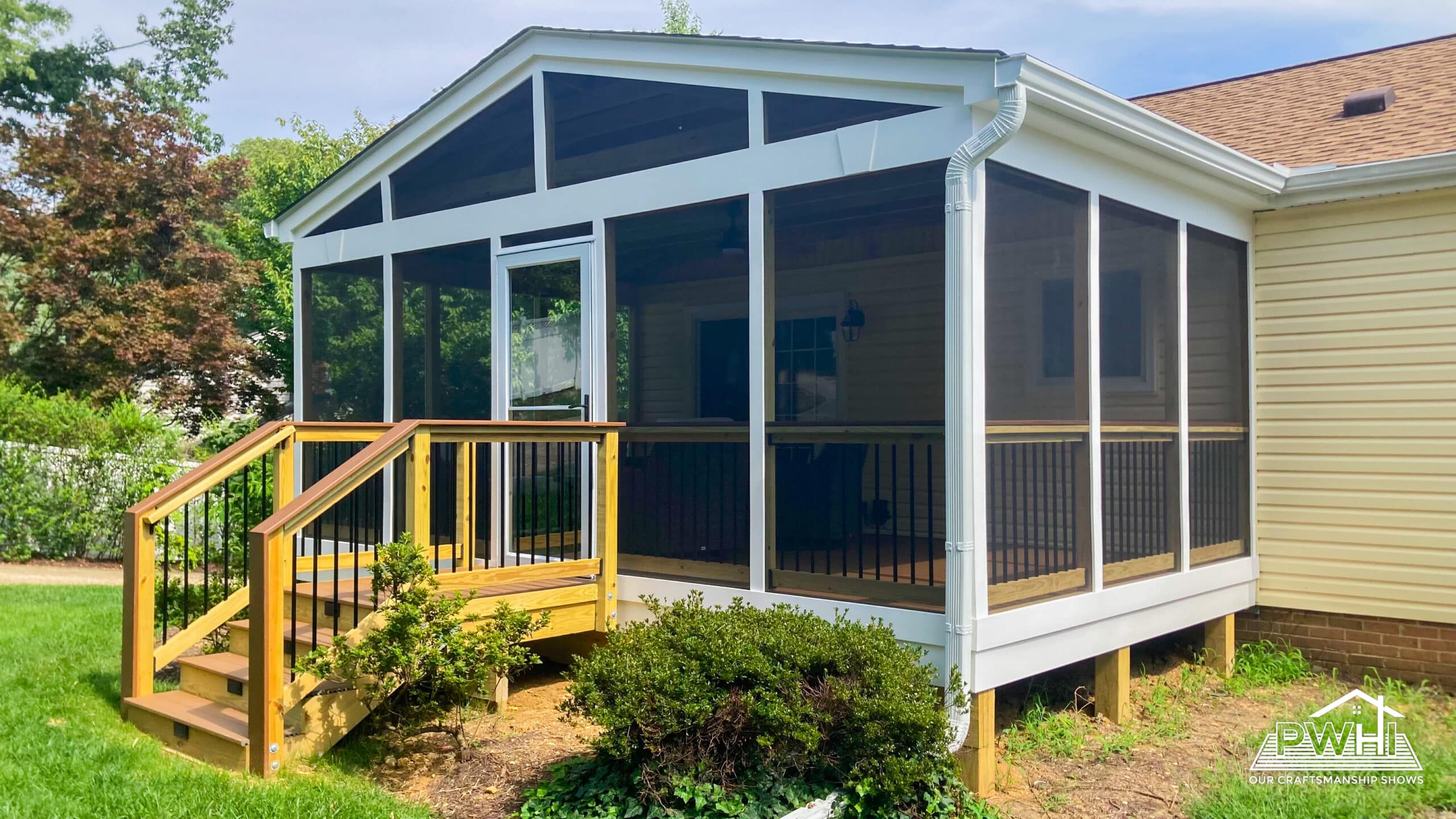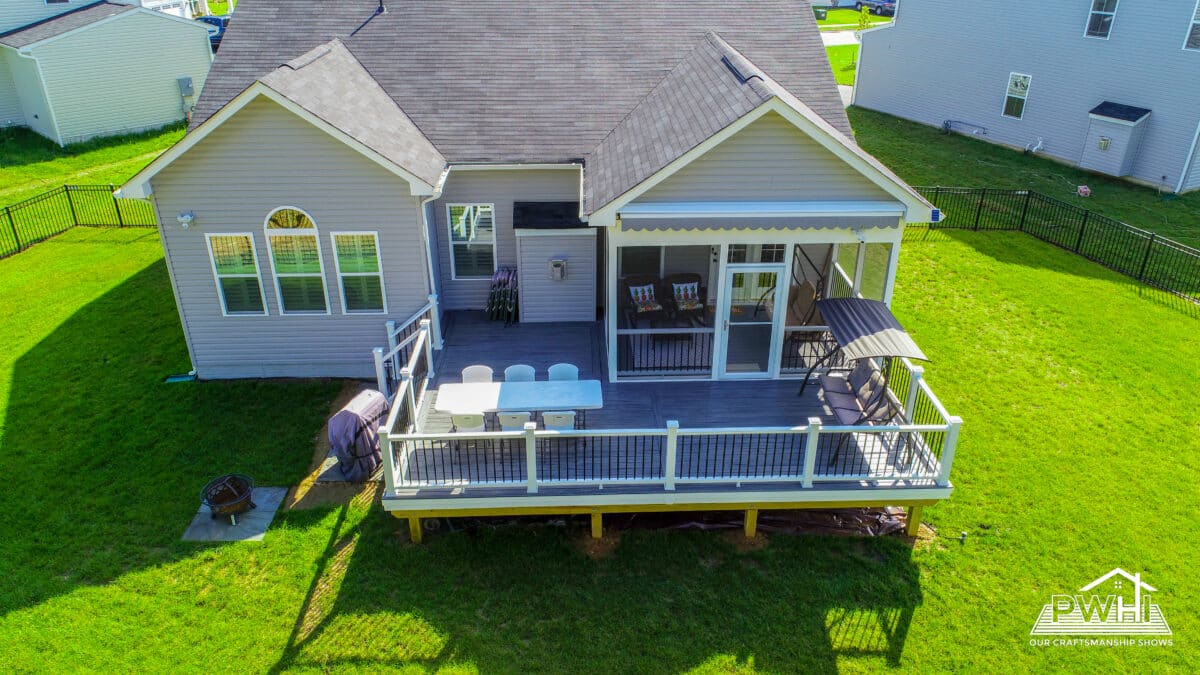If you’re looking for a three- or four-season room to extend your outdoor living space, an important choice is whether to opt for a screen room (screened porch) or a sunroom. Both provide views of your outdoor space, let more natural light into your property and deliver protection against pesky bugs and the elements. However, they have various benefits for homeowners beyond these factors.
Continue reading to compare a sunroom vs. a screened-in porch. This will help you decide which structure is the best-enclosed space for your family to enjoy enhanced access to the great outdoors.

What Is a Sunroom?
A sunroom addition is usually a complete home extension with a glass roof and glass panels, although it can be made with vinyl windows and a vinyl roof. Some might suggest that a sunroom offers protection from the elements all year. Still, this structure usually requires air conditioning or ceiling fans in summer and heating or a fireplace in the cold weather. In addition to being expensive to install, HVAC systems are an additional cost and impact the energy efficiency of your house.
Although you get beautiful outdoor views and direct sunlight from a sunroom, you’ll have to open the windows to let fresh air circulate in spring and summer. If you use an air conditioner to cool it, this can make the sunroom even less cost-effective and less energy-efficient.
Plus, the whole point of getting a sunroom is to enjoy the outdoor views from the inside. It’s an indoor room with windows and a view of the garden. While it might be seen as a pro to some people when selling your house, others might see the expense and potential for a hot or cold trap as a negative.
Pros and Cons of Adding a Sunroom
Pros of a Sunroom
- When you include insulation (e.g., argon filling) and an HVAC system with heating and cooling, you might be able to use it year-round
- Low E glass windows can make a sunroom addition more energy-efficient
- It might offer better protection for people with severe allergies to pollen or chronic diseases
- No tiny particles of dust or debris from the outdoors
Cons of a Sunroom
- You can’t easily add a sunroom onto your patio enclosures or any other existing structure
- Isn’t a true outdoor room with the sights, sounds and smells of nature
- If you opt for a room made of glass, it might be more of a hazard
- If something cracks or breaks, repairs are expensive
Thinking of adding a Screen Room in Virginia or Maryland?
Contact the #1 Screen Room Installer | PWHI
What Is a Screened Porch?
A screened porch is a structure with a roof and screens, allowing fresh air all year round while offering protection from pesky bugs and sunlight. One of the best things about an enclosed porch is its proximity to nature and its sights, smells and sounds. Whether you love watching the sunset, listening to the sound of the rain or basking in the heat under the shade, porch enclosures are perfect.
Regarding cost, a screen room is one of the most affordable ways to add square footage and value to your home. Construction is discreet and quick, but the result is a complete transformation of your house. It can offer direct access to your patio as the ideal transition between indoors and outdoors, and its versatility is unparalleled. If you want your screened porch to be enjoyed year-round, swap mesh panels for PVC in the winter or remove the screens entirely in summer.
There are different options available for materials and insulation. You can decide whether two, three, or four walls are screened, and the finished room can quickly adapt to decor and structure. It doesn’t trap heat or cold; instead, it reflects the outdoors and lets you get close to nature. Space heaters in the colder months will keep your feet warm while allowing you to breathe in fresh air.
Pros and Cons of Adding a Sunroom
A screen porch is the ideal choice if you’re looking for additional living space with full exposure to the heat of the sun, the sounds of nature, and a cool, refreshing breeze. Let’s break down the key pros and cons of installing a screened porch:
Pros of a Screened Porch
- Provides additional space to your home and patio without the requirement for extensive construction
- Protects against creepy-crawlies
- Offers additional living space to entertain while protecting against extreme temperatures
- Wide range of options for windows and doors — possibility to switch between solid and mesh screens and doors
- Easily transition between indoors and outdoors
- Affordable: Mainly inexpensive materials, so maintenance is cheaper
- Some see it as safer for children due to the lack of glass
- Enjoy the sun, breeze, sound of birds singing and smell of nature
- Protects outdoor furniture and decking
Cons of a Screened Porch
- There is no prospect for climate control beyond portable heaters and fans
- Isn’t a traditional indoor room
- Might not add as much property value
- Screens and frames need regular maintenance to keep them in good condition
- Depending on its location, a screened porch can reduce the amount of natural light that enters your home
- While providing protection and privacy, screens can also create a sense of being closed off from the full outdoor experience
- In Northern Virginia, it’s only comfortable half the year, the other half of the year, the porch can be unusable
- Does not reduce exposure to pollen and other outdoor allergens or dust

Types of Screened Porches
There are three main types of screened porches: screened porch with a solid roof, screened-roof porch and under-truss screen porch. Below is a description of the virtues of each.
A screened porch with a solid roof is the most highly favored type of screen porch for those without an existing porch. It’s usually made mainly from aluminum, making them sturdy and long-lasting. If you install a kickplate, less detritus from the outdoors can get in, helping protect your furniture.
This is the other most popular type of screened porch, but it’s only available to people with a porch installed. It uses your property’s existing footprint and protects against harsh sunlight and heavy rain, allowing you to bring a party under cover if rain starts quickly.
No Matter what type of Screen Room you’re looking for… Schedule a FREE In-Home Design Consultation
or Call 703-492-1294
No Matter what type of Screen Room you’re looking for… Schedule a FREE In-Home Design Consultation
or Call 703-492-1294
When Is the Best Time To Build a Screened Porch or Sunroom?
The best time to build a screen room is in the winter when the pollen count is low. It’ll be ready to use in time for spring and won’t interrupt daily life. Building a sunroom while the kids are at school is best, as it can be a significant undertaking. You or a family member might need to take time off to supervise the construction or make temporary alternate living arrangements to prevent daily life from slowing down the operation.
Screen Room vs Sunroom: The Verdict
Screen Room. Screened porches are an excellent choice for anyone looking to get closer to nature and bring the indoors outdoors without breaking the bank. Sunrooms are more like living rooms or dining rooms made of glass or PVC and cost significantly more, adding to your energy bills. We’d recommend going for a screened porch every time; it’s versatile, offers direct access to nature and can be insulated as much as you like to extend its use throughout the year.
Want a screened porch installed? Call PWHI at 703-492-1294 for more information or a free estimate.



